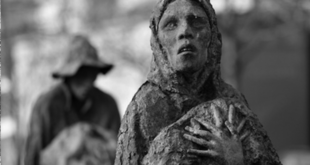Matthew Carr, the author of Blood and Faith, explains how the plight of the Moriscos, driven from their home country as detested aliens, has urgent lessons for our own age.

I first heard about the expulsion of the 17th-century Spanish Muslims known as Moriscos back in 1992, when I was living in Barcelona. This was during the 500th anniversary of Spain’s euphemistically titled “encounter” with the New World; I was familiar with the expulsion of the Jews by Ferdinand and Isabella in 1492, but I knew nothing of the tragedy of the Moriscos – known as “little Moors” – that took place more than a century later.
Even then, I was moved by the tragic fate of these forced converts to Christianity. They were marginalised and persecuted for more than a century before the Spanish state decided they were incapable of becoming “good and faithful” Christians – but they still considered themselves Spaniards even when they were dumped on the beaches of north Africa.
This episode did not sit well with the triumphalist tone of the quincentennial celebrations. At that time I had no idea that I would write a book about the Moriscos myself one day, but over the years I found myself thinking about this episode as I watched the increasingly abrasive relations between Europe and its Muslim minorities and the reinvention of Islam as a new existential enemy in the conservative and far-right political imagination. All these tendencies were exacerbated by 9/11 and the war on terror in the 2000s.
I was struck by the frequent references to the “loss” of the old Moorish kingdom of al-Andalus in the propaganda of al-Qaida and its offshoots and I often wondered why these references rarely included the Moriscos. For all these reasons, I thought it might be worthwhile to revisit this episode, and in 2007 I began researching the book that eventually became Blood and Faith.

I relied mostly on secondary sources, drawing on the brilliant work of generations of Spanish and international Morisco scholars. I read the key primary documents pertaining to the expulsion, and the often genocidal texts written by 17th-century anti-Morisco writers, like the sinister Dominican monk Jaime Bleda. I also wanted to capture the atmosphere of the period and visit some of the key locations. I went to the imposing castle of Simancas, where the Spanish state archives are kept, where I was shown a file of letters to Philip II written by local mayors and magistrates during the brutal transportation of Morisco rebels from Granada to Castile in the winter of 1570. Most of these short messages described the appalling physical condition of the sick and starving men, women and children who passed before their eyes that harsh winter, and the impossibility of feeding or even clothing them. The official attitude towards these defeated people was not celebratory. On the contrary, their authors were often shocked and dismayed at what they saw.
Reading those yellowed, barely legible letters, I felt that I was holding history in my fingers. I was struck by the simple humanity of these officials, which contrasted so dramatically with the brutal events that followed the promulgation of Philip III’s expulsion order in Valencia in September 1609. That year, thousands of Valencian Moriscos fought a doomed battle to resist their expulsion at the village of Cortes de Pallás. I visited with the local historian Miguel Aparici Navarro, who showed me the ruins of Morisco villages, and the great ridge known as the muella – where Morisco women had thrown themselves to their deaths with their children, rather than leave the country they considered their homeland.
The battles at Cortes de Pallás were celebrated in one of the triumphal paintings commissioned by Philip III to mark the occasion; today these paintings are kept in a bank in Valencia and not open to the public. One afternoon, I persuaded the bank to let me in, and I was allowed to look at them on my own.
These paintings were intended to glorify what many statesmen even then regarded as a crime. Like most documents pertaining to the expulsion, they told its story from the point of view of the victors. I wanted to tell a different story; of how what was then the most powerful state in Europe was driven by fear and bigotry to destroy a defenceless minority and act against its own material interests.
These tendencies are present in every society and in every era. I hoped then, as I hope now, that Blood and Faith might make readers more alert to the destructive possibilities in our own.
Extract
Poignant and often tragic scenes unfolded as the Moriscos were brought to the waiting ships. One old man arrived in Valencia declaring his wish to be buried on Muslim soil but dropped dead while boarding his ship. Other Moriscos died of hunger and exhaustion before leaving the shore. Some parents became separated from their children in the confusion; others left their children behind with local Christians. In the Valencian artist Pere Oromig’s painting Departure of the Moriscos from the Port of Valencia, a Morisco father can be seen kneeling to say goodbye to his young daughter, who is standing with a Christian family.
There were many such farewells as the exodus continued. Even as the Moriscos were boarding their ships, priests, monks, and zealous Christians pleaded with them to leave their children behind so that they could be brought up as Catholics … Doña Isabel de Velasco, personally persuaded many parents to leave their children behind – or had them kidnapped – for their spiritual salvation. Some Moriscos gave in to these opportunities because they felt unable to care for their children, but others defiantly refused, such as the Morisca who gave birth on the docks and then “embarked with the infant in her arms on a harsh, windy and very cold day,” according to a report by the Valencia Inquisition, and ignored the Christians who begged her to leave her baby with them.
Source : https://www.theguardian.com
Post Disclaimer | Support Us
Support Us
The sailanmuslim.com web site entirely supported by individual donors and well wishers. If you regularly visit this site and wish to show your appreciation, or if you wish to see further development of sailanmuslim.com, please donate us
IMPORTANT : All content hosted on sailanmuslim.com is solely for non-commercial purposes and with the permission of original copyright holders. Any other use of the hosted content, such as for financial gain, requires express approval from the copyright owners.
 Sri lanka Muslims Web Portal Sri Lanka Muslims News Center
Sri lanka Muslims Web Portal Sri Lanka Muslims News Center
 Donate
Donate


